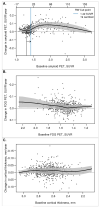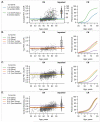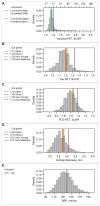Defining imaging biomarker cut points for brain aging and Alzheimer's disease
- PMID: 27697430
- PMCID: PMC5344738
- DOI: 10.1016/j.jalz.2016.08.005
Defining imaging biomarker cut points for brain aging and Alzheimer's disease
Abstract
Introduction: Our goal was to develop cut points for amyloid positron emission tomography (PET), tau PET, flouro-deoxyglucose (FDG) PET, and MRI cortical thickness.
Methods: We examined five methods for determining cut points.
Results: The reliable worsening method produced a cut point only for amyloid PET. The specificity, sensitivity, and accuracy of cognitively impaired versus young clinically normal (CN) methods labeled the most people abnormal and all gave similar cut points for tau PET, FDG PET, and cortical thickness. Cut points defined using the accuracy of cognitively impaired versus age-matched CN method labeled fewer people abnormal.
Discussion: In the future, we will use a single cut point for amyloid PET (standardized uptake value ratio, 1.42; centiloid, 19) based on the reliable worsening cut point method. We will base lenient cut points for tau PET, FDG PET, and cortical thickness on the accuracy of cognitively impaired versus young CN method and base conservative cut points on the accuracy of cognitively impaired versus age-matched CN method.
Keywords: Alzheimer's MRI; Alzheimer's biomarkers; Alzheimer's disease; Alzheimer's imaging; Amyloid PET; FDG PET; Quantitative imaging; Tau PET.
Copyright © 2016 The Authors. Published by Elsevier Inc. All rights reserved.
Figures





References
-
- Hampel H, Schneider LS, Giacobini E, Kivipelto M, Sindi S, Dubois B, et al. Advances in the therapy of Alzheimer’s disease: targeting amyloid beta and tau and perspectives for the future. Expert Rev Neurother. 2015;15:83–105. - PubMed
-
- Dubois B, Feldman HH, Jacova C, Hampel H, Molinuevo JL, Blennow K, et al. Advancing research diagnostic criteria for Alzheimer’s disease: the IWG-2 criteria. Lancet Neurol. 2014;13:614–29. - PubMed
MeSH terms
Substances
Grants and funding
LinkOut - more resources
Full Text Sources
Other Literature Sources
Medical
Molecular Biology Databases

